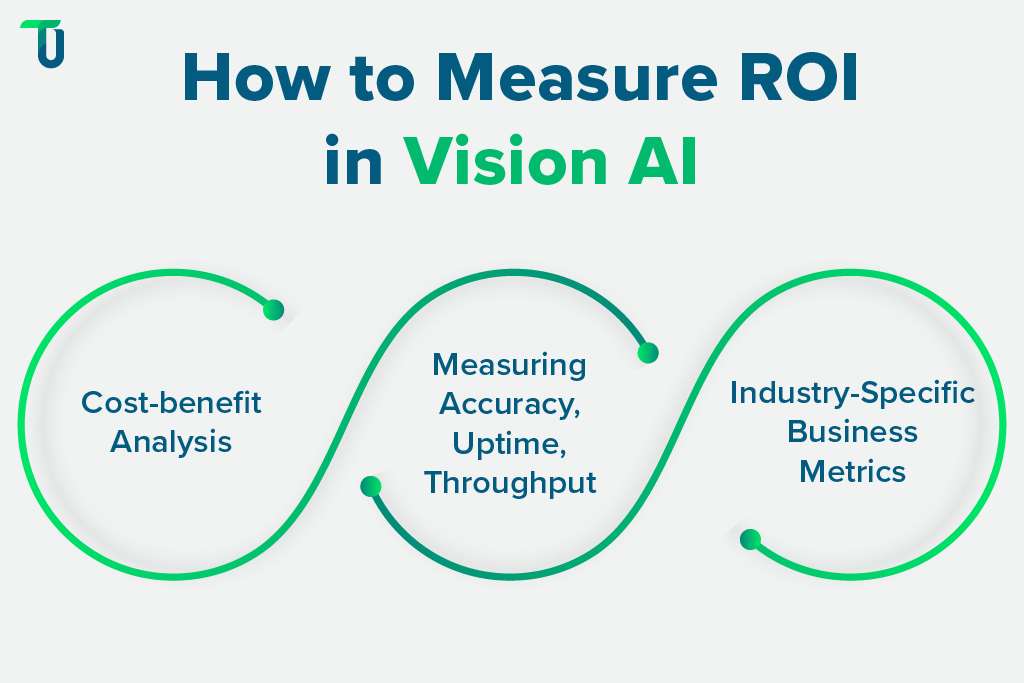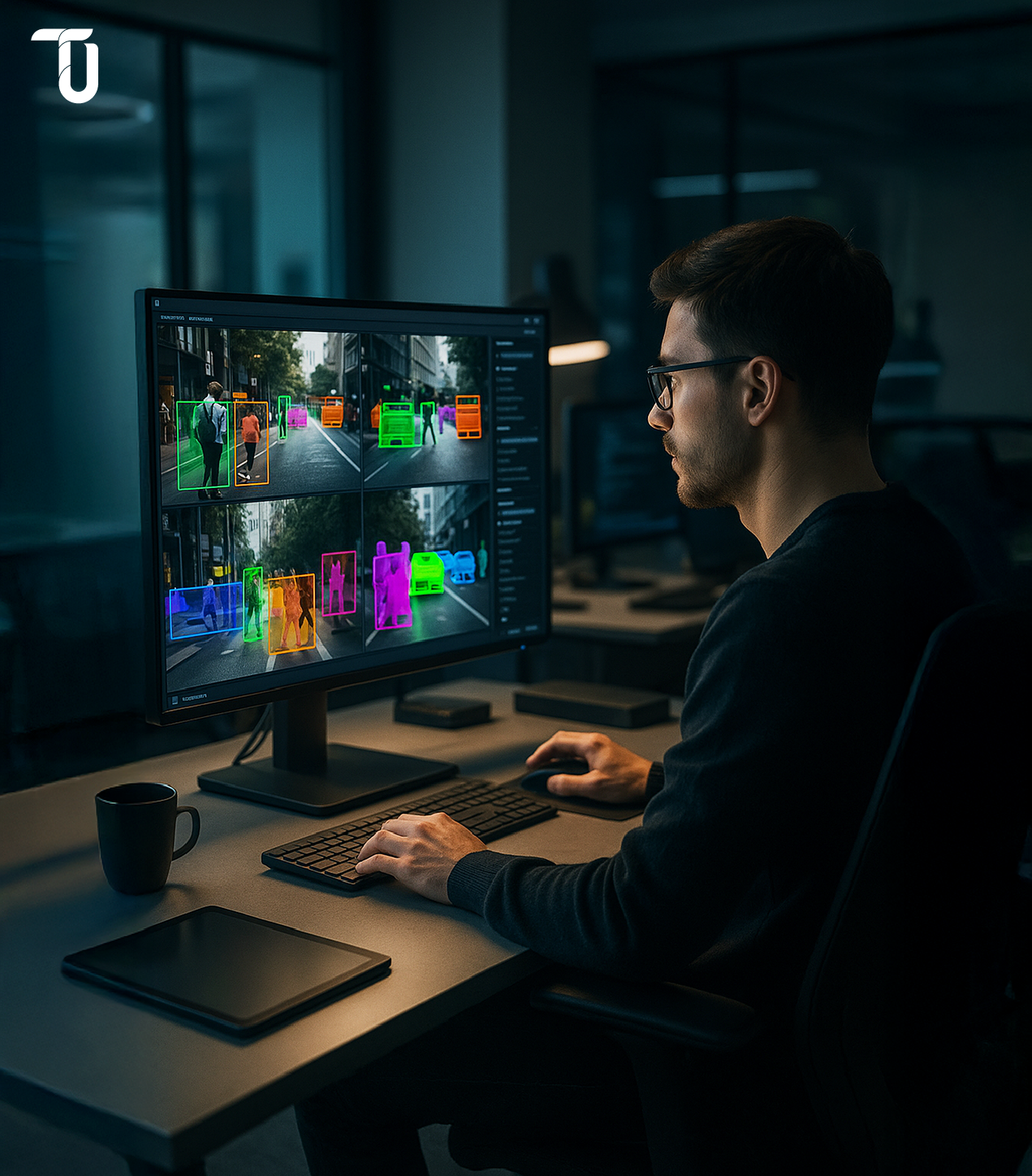What Powers Computer Vision? A Quick, No-Fluff Breakdown
Let’s get real—before you invest in computer vision, you need to know what’s under the hood. Not just the buzzwords, but the nuts and bolts that make it work at scale.
So, What Is Computer Vision?
Computer vision is a field of artificial intelligence (AI) that enables machines to interpret and understand visual information from the world—images, video, and live camera feeds. While computer vision enables machines to interpret static images and video feeds, image-to-video AI turns still visuals into motion sequences —bringing a new dimension to content creation through advanced generative models. It’s not just about passively recording visuals, but about making sense of them in context. Think: spotting defects on an assembly line, identifying faces in a crowd, or tracking inventory in real time. At its core, computer vision turns unstructured visual data into actionable business insights and automated decisions.
How Does It Work?
Here’s the short version:
Capture: Cameras or sensors grab the visuals.
Process: AI models analyze what’s in the frame—detect, classify, segment—such as the Custom segmentation models for car photography used to render realistic shadows and window effects in automotive images.
Act: The system outputs structured insights you can plug right into business workflows. It’s fast, automated, and only as smart as the tech stack behind it.
The Stack: What You Really Need
A working computer vision system rests on three pillars:
Cameras/Sensors: Eyes on the field.
AI Models: The brain interpreting what it sees.
Infrastructure (Edge/Cloud): Where the magic happens—processing, storing, scaling.
Choosing the right combo isn’t just technical—it impacts accuracy, latency, and ROI. Don’t skimp here.
Wait—Isn’t That Just AI Vision or Image Processing?
Not quite. Let’s clear the fog:
- Computer Vision teaches machines to see and understand.
- AI Vision Systems layer in intelligence, learning, automation, and decision-making.
- Image Processing is more cosmetic, enhancing visuals without meaning or context.
In reality, you’ll use all three in tandem to build computer vision solutions that actually move the needle.
Top Computer Vision Use Cases Across Industries
Custom-built computer vision solutions are transforming how industries operate. The shift is no longer about automation for the sake of speed. It’s about precision, consistency, and real-time intelligence. Here’s how different sectors are using computer vision technology to solve real business problems.

Manufacturing: Quality Inspection and Defect Detection
Manual inspection slows production and misses micro-defects. Computer vision systems automate this with high-speed cameras and AI models trained to detect flaws with pinpoint accuracy. This reduces rework, waste, and cost.
Healthcare: Diagnostics, Imaging, and Monitoring
From tumor detection in radiology scans to patient monitoring in ICUs, AI vision systems are helping clinicians make faster, more accurate decisions. These systems analyze medical images at scale while reducing diagnostic errors.
Retail: Visual Search and Shelf Analytics
In retail, computer vision tools enhance customer experience and backend efficiency. Smart cameras track inventory in real time, detect shelf gaps, and enable visual product search to simplify shopper journeys - and in some cases, support automated background removal for e-commerce-ready visuals.
Agriculture: Precision Farming and Pest Detection
Farms are deploying computer vision solutions to monitor crop health, identify weeds, and detect pests early. Using drones and edge devices, these systems reduce pesticide use and improve yields season after season.
Transportation and Logistics: Traffic Management and Safety
From real-time vehicle tracking to automated license plate recognition, computer vision systems improve fleet visibility and road safety. In logistics hubs, they streamline cargo handling and reduce bottlenecks—making it an ideal environment to Deploy Image Segmentation in Your Warehouse Today for measurable ROI and efficiency gains.
Security and Surveillance: Anomaly and Intrusion Detection
Traditional CCTV is reactive. AI vision systems make surveillance proactive. By detecting unusual patterns, unauthorized entries, real-time events, or suspicious behavior, these systems reduce human dependency and response time.
Move Beyond the Pilot
Most vision projects stall after testing. We help you take the next step into scalable, production-ready solutions.
Building a Computer Vision Solution: Step-by-Step
Developing a computer vision solution isn’t just about training a model. It’s about solving a real-world business problem at scale. This section breaks down the complete lifecycle of building production-grade computer vision systems, from aligning with business goals to ensuring the model continues to improve in the wild.

1. Problem Definition and Business Alignment
Start with clarity. Identify a clear business use case, such as reducing defects on a manufacturing line, automating document verification, or tracking crop health in agriculture. Map this to measurable outcomes like time saved, cost reduced, or accuracy improved. Without this alignment, even the most sophisticated model will miss the mark.
2. Data Collection & Annotation
Computer vision lives and dies by the quality of its data. Collect representative visual data from your actual environment, including images, videos, and sensor feeds. Then, annotate it with precision using bounding boxes, segmentation masks, or keypoints, depending on your task. Annotation can be done manually, semi-automatically, or with AI-assisted tools, but consistency is non-negotiable.
TenUp Software Services built a fish recognition system trained on a dataset of 72,000 subspecies using a fine-grained classification model.
3. Choosing the Right Computer Vision Models
Not all models are created equal. Use object detection models like YOLO or SSD for real-time applications. For fine-grained classification, consider ResNet or EfficientNet. For enterprises exploring the latest technologies, understanding the best AI tools for image-to-video conversion is essential to create dynamic and scalable video content from images. If speed matters more than accuracy, lightweight models may suffice. Also, weigh the tradeoffs between pre-trained models and custom-trained ones based on your domain specificity.
TenUp Software Services helped a photography giant build a Vision AI solution using a BiRefNet model to outperform off-the-shelf tools for background removal and replacement.
4. Training and Validation
Split your dataset into training, validation, and test sets. Train your model using frameworks like TensorFlow or PyTorch, fine-tune hyperparameters, and validate regularly to avoid overfitting. This stage is iterative. You may need to revisit your data or model choice based on validation performance.
5. Integration with Business Systems
A working model isn't a solution unless it's integrated. Wrap your trained model into an API or microservice. Connect it with your existing applications, such as ERPs, dashboards, mobile apps, or control systems. This ensures that predictions translate into real-world decisions and actions.
6. Testing in Real-World Conditions
Lab accuracy isn’t enough. Test your solution under realistic operating conditions, including variable lighting, occlusions, and edge-case scenarios — a principle covered in our guide to custom image recognition systems from AI experts. Simulate failure modes. Ensure performance holds up under load and that edge cases are flagged instead of misclassified.
Our custom-built fish identification app was tested in varying marine environments, and the solution achieved 85% accuracy within 2 seconds while updating regulatory rules.
The image background removal tool we developed processed full-resolution 4K images with fine detail in window edges, consistent with our client’s needs.
7. Continuous Learning and Feedback Loops
Computer vision is not a one-and-done game. Set up feedback loops to collect mislabeled data, edge cases, and performance logs. Use this data to retrain your models, adapt to drift, and improve over time. Incorporating MLOps practices will help you automate these iterations and keep the system fresh, accurate, and aligned with your evolving business needs.
Key Technologies Powering Computer Vision
Behind every successful computer vision solution is a stack of technologies working in sync. From raw compute power to sophisticated learning algorithms, these components are what make modern AI vision systems fast, accurate, and scalable. Here’s what’s driving enterprise-grade performance today:
1. AI and Deep Learning Foundations
At the heart of computer vision technology is deep learning. Convolutional Neural Networks (CNNs) and transformers are widely used to extract patterns from images and video. These models get smarter over time as they process more annotated data and edge cases. If your use case demands high precision and adaptability, deep learning is non-negotiable.
2. Hardware: GPUs, Edge Devices, and Smart Cameras
Processing visual data is compute-heavy. You need the right hardware to match your speed and scale requirements.
What to consider:
- GPUs for training large models with massive datasets
- Edge devices for on-site processing where latency matters
- Smart cameras with built-in AI capabilities to reduce infrastructure overhead
Enterprises are increasingly choosing edge deployment to save on bandwidth and enable real-time decision-making.
3. MLOps for Vision Projects
Deploying and managing models in production is a different game from prototyping. This is where MLOps steps in.
What it enables:
- Version control for datasets and models
- Automated pipelines for training, validation, and deployment
- Continuous monitoring to detect model drift and trigger retraining
Think of MLOps as DevOps for AI. It ensures your computer vision systems remain reliable, scalable, and performance-optimized over time.
Deployment Pitfalls and How to Avoid Them
Even the best computer vision solutions can fail in the real world if deployment isn’t done right. From unpredictable data to compliance blind spots, several challenges can stall your progress and eat into ROI.
Here’s what to watch for and how to stay ahead.

1. Model Drift and Real-World Variability
Your model may perform perfectly in the lab but falter in the field. Why? Because real-world environments change.
Lighting shifts. Product packaging evolves. Cameras get repositioned. These variations can degrade performance over time.
What to do:
- Set up real-time monitoring for accuracy and anomaly detection
- Automate model retraining pipelines using new data samples
- Build feedback loops into user workflows for continuous improvement
2. Data Privacy and Compliance
Visual data often includes sensitive information. This is especially critical in industries like healthcare, retail, and logistics, where regulatory oversight is tight.
What to enforce:
- Clear policies around data collection, storage, and usage
- Region-specific compliance standards such as HIPAA, GDPR, and CCPA
- Role-based access controls for internal users interacting with visual data
3. Real-Time vs Batch Constraints
Not every use case demands real-time processing, but when it does, latency becomes a major hurdle. Choosing the wrong architecture can stall your deployment.
What to assess:
- Whether the use case needs instant feedback or periodic analysis
- Edge vs cloud processing based on latency and bandwidth
- Optimization techniques like quantization or model pruning to improve speed
4. Workforce Training and Adoption
A powerful computer vision system is useless if your team doesn’t know how to use it.
What to plan for:
- Simple user interfaces that abstract model complexity
- Training programs for operators, analysts, and decision-makers
- Internal documentation and change management strategies
Avoiding these pitfalls early can save months of rework and protect your investment. A thoughtful deployment strategy ensures that your AI vision system not only works but delivers continuous value.
Measuring ROI of Computer Vision Initiatives
Enterprise leaders don’t invest in tech for hype. They invest for outcomes. And when it comes to computer vision solutions, ROI isn't just about automation. It's about operational efficiency, error reduction, and decision speed.

Cost-Benefit Breakdown: Pilot vs Full-Scale
Most projects start with a limited rollout. Pilots help validate use cases, assess model performance, and uncover infrastructure needs. While upfront costs go into data labeling, model training, and hardware, full-scale computer vision systems unlock real savings through reduced labor, fewer defects, and faster processing.
KPIs for Vision Systems
Success isn't subjective. Here are key performance indicators to measure ROI:
- Accuracy: How often the system identifies or classifies correctly
- Uptime: System availability in real-world conditions
- Throughput: How many inspections, detections, or decisions per minute
Monitoring these helps ensure your AI vision systems are not just deployed but actually delivering value.
Business Impact Metrics by Industry
Every industry measures value differently:
- Manufacturing looks at defect rate reduction and downtime
- Retail tracks inventory visibility and planogram compliance
- Healthcare focuses on faster diagnostics and reduced readmission rates
- Agriculture sees ROI in pesticide savings and yield improvements
The key is tying computer vision technology back to a business metric that matters.
The Future of Computer Vision Solutions
As industries mature in their use of computer vision solutions, the frontier is shifting. It's no longer just about detecting what's in an image. It's about understanding context, making predictions, and learning faster from less data. Here's what’s coming next in computer vision technology.
Generative AI and Synthetic Data for Training
Labeled data is expensive. Generative AI is changing that. Enterprises are using synthetic data to train computer vision systems when real-world datasets are limited, biased, or hard to collect. This speeds up development while improving model generalization.
Vision-Language Models (VLMs)
The next wave of AI vision systems combines images with natural language. VLMs can understand prompts like “find all defective parts with a crack longer than 2mm” and respond visually. This fusion opens up powerful new applications in analytics, compliance, and automation.
3D Vision and Spatial Understanding
Moving beyond 2D recognition, 3D computer vision tools are enabling robots to navigate space, measure depth, and interact with physical environments. From autonomous vehicles to AR product visualization, spatial intelligence is becoming a must-have.
Real-Time Edge Inference and TinyML
Not every vision workload belongs in the cloud. With edge computing and TinyML, computer vision solutions are running directly on devices with limited compute—think drones, cameras, or wearables. This brings lower latency, reduced bandwidth costs, and faster decision-making.
The future of computer vision is not only smarter, it’s more accessible. With the right tools for computer vision, enterprises can build systems that don’t just see but also understand and act in real time, at scale.
What CTOs/CEOs Should Prepare for?
Vision systems are becoming more strategic. They will move from task-specific deployments to platform-level integrations that serve multiple departments.
What to focus on:
- Future-proofing your architecture for edge, cloud, and hybrid workloads
- Investing in reusable data pipelines and model governance
- Building cross-functional teams that combine data, engineering, and business expertise
The next three years will reshape how businesses capture and act on visual data. Those who invest early in scalable, responsible computer vision solutions will be better positioned to lead their industries.
From POC to Production-Ready: Why TenUp Software Is the Right Vision Partner
Turning a computer vision idea into enterprise-grade impact is not just about choosing the right tools. It’s about having the right engineering partner who understands your business objectives, your data landscape, and your speed-to-market goals.
At TenUp Software Services, we specialize in building custom computer vision solutions that are reliable, scalable, and production-ready. Whether you're deploying AI vision systems at the edge, training multimodal models, or integrating vision into cloud-native platforms, we help you do it right.
Our AI Engineering team brings:
- End-to-end expertise across data collection, model training, and deployment
- Cross-domain experience with retail, manufacturing, logistics, healthcare, and more
- Deep proficiency with vision frameworks like YOLO, TensorFlow, Detectron2, and enterprise MLOps
We don’t just build models. We design solutions that align with your roadmap, accelerate ROI, and deliver a lasting competitive advantage.
Don’t Just Use AI. Own It.
Get in touch today to see how TenUp Software Services can help you build vision systems that move your business forward.
Frequently asked questions
What are the key criteria to help decide whether to build a computer vision system in-house or buy a commercial solution?
Build in-house if you need deep customization, own the IP, or have strong internal AI expertise. Buy if speed, lower upfront cost, and vendor support are priorities. Consider factors like use-case complexity, time-to-market, scalability, and long-term maintenance.
How do you choose the right computer vision model architecture (e.g., YOLO, ResNet, EfficientNet) for a specific business use case?
Choose YOLO or SSD for real-time detection with speed. Use ResNet or EfficientNet when accuracy matters, especially for detailed classification. Match the model to your compute limits, latency goals, and dataset size. For edge devices, opt for lightweight models; for cloud, go deeper. Always balance performance with deployment constraints.
What are practical steps to optimize deep-learning computer vision for real-time embedded or edge deployment?
Start with model compression—quantize, prune, or distill to reduce size. Choose lightweight models like MobileNet or EfficientNet. Use edge-ready runtimes like TensorRT or TFLite. Align model design with hardware (e.g., NPU, GPU). Benchmark for latency and power on target devices. Prioritize speed without sacrificing core accuracy.
How do you detect and mitigate model drift in deployed computer vision systems over time?
Monitor key metrics in production (e.g., accuracy drop, input data drift). Use threshold triggers or anomaly detection to flag issues early. Retrain with updated samples via automated pipelines. Maintain shadow models for safe testing and enable fast rollback if drift impacts performance.
What ML pipeline patterns best support fine-grained tasks like defect detection, segmentation, or OCR at scale?
Break the pipeline into modular stages—preprocessing, detection, segmentation, and OCR. Use task-specific models (e.g., U-Net, Mask R-CNN), optimize annotation with AI-assisted tools, and deploy via scalable microservices. Continuously retrain with user feedback to refine accuracy and adapt to data drift.
How do you evaluate ROI and business impact from enterprise computer vision deployments?
Measure ROI by tracking business-aligned KPIs like defect reduction, labor cost savings, or faster turnaround times. Compare pilot vs full-scale performance—manual vs automated throughput. Then tie those outcomes to revenue gains, reduced waste, or time saved to quantify real business value. Always align metrics with use-case goals.
What trade-offs exist between pre-trained vision models vs custom-built models in enterprise environments?
Pre-trained models offer fast, low-cost deployment for general tasks, but may lack accuracy on domain-specific data. Custom models take longer and cost more to build, but deliver better performance, control, and alignment with business needs. Choose pre-trained for speed; go custom when accuracy, IP, or data sensitivity matter.

